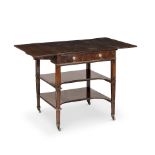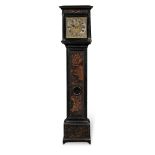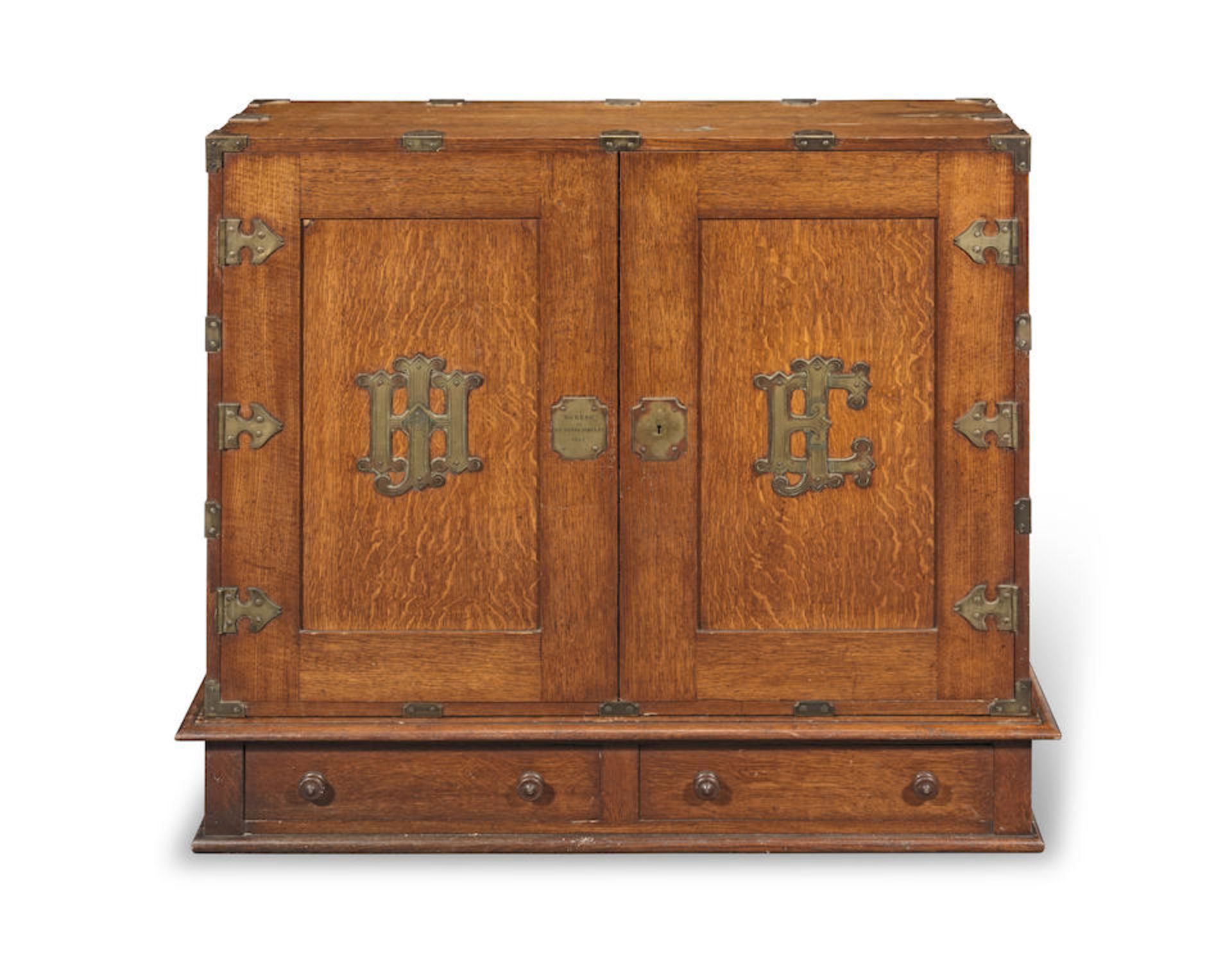13
A mid Victorian brass mounted oak campaign or 'travelling' cabinet made for and originally belon...
A mid Victorian brass mounted oak campaign or 'travelling' cabinet made for and originally belonging to Sir Henry James R.E. Circa 1860, almost certainly originally having a lower section In two sections, with a pair of panelled doors, each door mounted with an engraved brass monogram (one bearing: 'H.J.' and the other: 'E.J.'), with a central brass plaque engraved: 'Bureau of Sir Henry James R.E., 1862', enclosing a pair of panelled doors, each door inset with a depiction of Sir Henry James within an oval, one oval possibly a lithograph showing him as a younger man and a Captain, the other oval a photographic representation of him as an older man and as Colonel Sir Henry James, flanked by eight pigeon holes, above four short drawers, with two short frieze drawers below, approximately: 114cm wide x 41cm deep x 104cm high, (44 1/2in wide x 16in deep x 40 1/2in high) Footnotes: Provenance Property of a UK collector. The offered lot was evidently made for and originally belonged to Lieutenant General Sir Henry James Kt FRS MRIA FGS (1803-1877). Sir Henry James was an officer who served in the Royal Engineers and then worked for the Ordnance Survey, eventually going on to become Director-General. He is perhaps best known for introducing the new science of photography into the operation of the O.S. In his later years, James claimed to have been responsible for inventing the new process referred to as Photozincography or Zinco although this has since become a much debated and somewhat controversial topic. Sir Henry James gained his commission as a Second Lieutenant in the Royal Engineers in 1826, but was promoted to the level of Captain in 1846 and had reached the level of Colonel by 1857. Henry spent most of his career working for the Ordnance Survey, predominantly in Ireland, although following a short period where he was based at the Admiralty, he was eventually given control of the Edinburgh Office in 1850. James took over as Superintendent of the Ordnance Survey (effectively Director-General) from 1854 until his retirement in 1875. He established a photography department at the O.S. in order to effect a reduction in the scale of their maps. One of his claims was that he had invented a photographic means of producing printing plates which was called photozincography. However subsequent to this claim, it was believed that it was in actual fact a new process devised by two of his team instead. But the reality is that Henry James was the main motivating force behind ideas such as the creation and subsequent publication of a facsimile of the historic Domesday Book. As a result of these advancements, and following his knighthood in 1860 for services to science, a number of governments abroad were understandably amazed by this new Zinco method. Among them, the Queen of Spain at the time was sufficiently impressed to make him a member of the Order of Isabella the Catholic. https://en.wikipedia.org/wiki/Henry_James_(British_Army_officer) For further information on this lot please visit Bonhams.com For further information about this lot please visit the lot listing
A mid Victorian brass mounted oak campaign or 'travelling' cabinet made for and originally belonging to Sir Henry James R.E. Circa 1860, almost certainly originally having a lower section In two sections, with a pair of panelled doors, each door mounted with an engraved brass monogram (one bearing: 'H.J.' and the other: 'E.J.'), with a central brass plaque engraved: 'Bureau of Sir Henry James R.E., 1862', enclosing a pair of panelled doors, each door inset with a depiction of Sir Henry James within an oval, one oval possibly a lithograph showing him as a younger man and a Captain, the other oval a photographic representation of him as an older man and as Colonel Sir Henry James, flanked by eight pigeon holes, above four short drawers, with two short frieze drawers below, approximately: 114cm wide x 41cm deep x 104cm high, (44 1/2in wide x 16in deep x 40 1/2in high) Footnotes: Provenance Property of a UK collector. The offered lot was evidently made for and originally belonged to Lieutenant General Sir Henry James Kt FRS MRIA FGS (1803-1877). Sir Henry James was an officer who served in the Royal Engineers and then worked for the Ordnance Survey, eventually going on to become Director-General. He is perhaps best known for introducing the new science of photography into the operation of the O.S. In his later years, James claimed to have been responsible for inventing the new process referred to as Photozincography or Zinco although this has since become a much debated and somewhat controversial topic. Sir Henry James gained his commission as a Second Lieutenant in the Royal Engineers in 1826, but was promoted to the level of Captain in 1846 and had reached the level of Colonel by 1857. Henry spent most of his career working for the Ordnance Survey, predominantly in Ireland, although following a short period where he was based at the Admiralty, he was eventually given control of the Edinburgh Office in 1850. James took over as Superintendent of the Ordnance Survey (effectively Director-General) from 1854 until his retirement in 1875. He established a photography department at the O.S. in order to effect a reduction in the scale of their maps. One of his claims was that he had invented a photographic means of producing printing plates which was called photozincography. However subsequent to this claim, it was believed that it was in actual fact a new process devised by two of his team instead. But the reality is that Henry James was the main motivating force behind ideas such as the creation and subsequent publication of a facsimile of the historic Domesday Book. As a result of these advancements, and following his knighthood in 1860 for services to science, a number of governments abroad were understandably amazed by this new Zinco method. Among them, the Queen of Spain at the time was sufficiently impressed to make him a member of the Order of Isabella the Catholic. https://en.wikipedia.org/wiki/Henry_James_(British_Army_officer) For further information on this lot please visit Bonhams.com For further information about this lot please visit the lot listing






